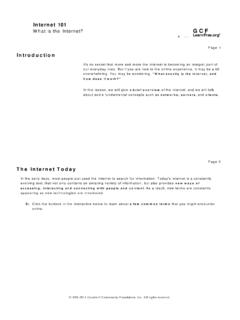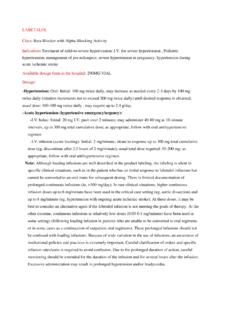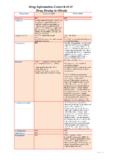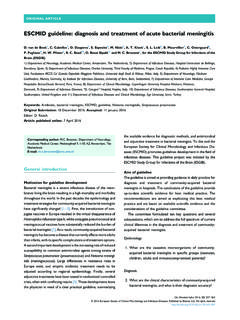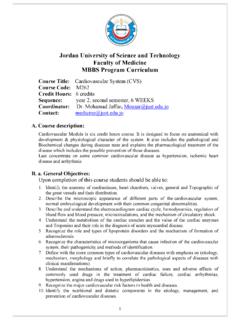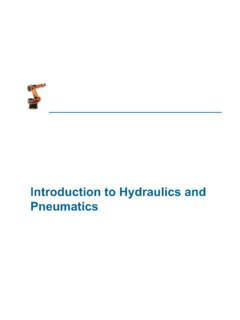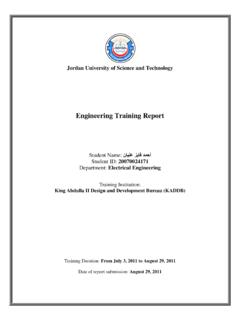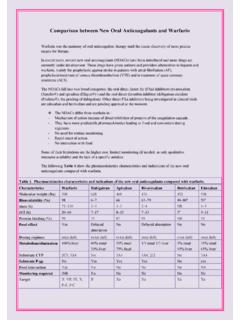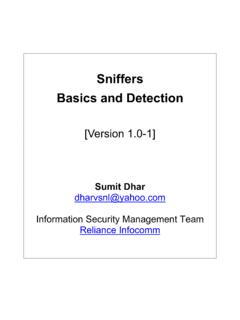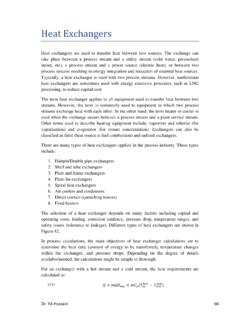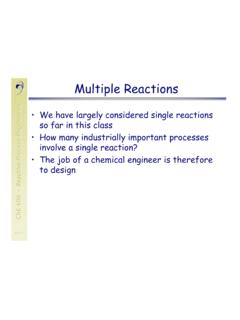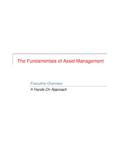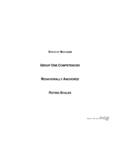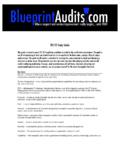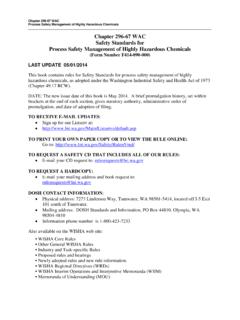Transcription of Reactors - Jordan University of Science and Technology
1 95 Reactors Reactions are usually the heart of the chemical processes in which relatively cheap raw materials are converted to more economically favorable products. In other cases, reactions play essential safety and environmental protection roles. In any case, proper design and operation of the reactor is required to provide the desired outcome. Such design is usually based on thermodynamics, chemical kinetics, and transport studies coupled with experience and economic considerations. When studying chemical reactions we need to determine what are the reactants and products needed, to what extent will the reaction proceed, and how fast it will proceed. The study of such factors in addition to the detailed design of the reactor consist the chemical reaction engineering field in which process simulation can be of great help. Aspen Plus provides several libraries to model reactive processes . The selection of the model depends on the amount of information available and the type of simulation.
2 Reaction Classifications There are several ways to classify a chemical reaction. For example, reactions can be classified as reversible and irreversible reactions. In reversible reactions, the reactants are converted to products at a certain rate while the products are converted to reactants at a different rate. At equilibrium, the two rates become equal. An example of reversible reaction is the formation of ammonia from hydrogen and nitrogen: In irreversible reactions, on the other hand, the rate of conversion of products to reactants is zero. For example, the hydration of calcium oxide to form calcium hydroxide is an irreversible reaction: ( ) Another classification of reactions is based on the phase(s) involved. In this classification, a homogeneous reaction is defined as a reaction which occurs in one phase. On the other hand, a heterogeneous reaction requires the presence of two or more phases for the reaction to take place (regardless of where the reaction is occurring).
3 For example, the burning of methane is a homogeneous reaction since it occurs in the gas phase only. On the other hand, burning coal is a heterogeneous reaction since the presence of oxygen (gas) and coal (solid) are needed to complete the reaction. When considering the phase of the reaction, it is important to distinguish between the phases present during a reaction and the phases in which the reaction occurs. For example, an oxygen scavenging system such as sodium sulfite (Na2SO3) solution when used to remove oxygen from a gas stream, the gas will have to dissolve in the solution for the oxygen to be removed. Thus, Dr. YA Hussain 96 while the reaction is heterogeneous (requires the presence of gas and liquid phases), the reaction occurs in the liquid phase only. Material Balance on Reactive processes For the general reaction: (28) occurring in the process shown in Figure 67. The amount of each component entering the system is known, and the objective is to determine the outlet composition.
4 One approach to solve this material balance is to use the fractional conversion of one of the materials. The fraction conversion is defined as: (29) Of course, ranges from 0 to 1. Then, the outlet of component can be determined by rearranging Equation (29) to give: (30) ( ) Using stoichiometry, the outlet for other components can be calculated. In the example in Figure 67, if the conversion of is known ( ), then the outlet flow rates can be written as: Alternatively, the extent of reaction can be used. The extent of reaction can be viewed as a hypothetical product for which one molecule (or mole) is produced each time a reaction event occurs. The extent of reaction ( ) is used to define the output from the reaction using the following expression: (32) ReactornAonBonConDonIonAnBnCnDnI Figure 67. Simple reactor block. (31)a ( ) (31)b ( ) (31)c ( ) (31)d ( ) 97 where a summation is used to account for the presence of multiple reactions (denoted by the subscript ), and denotes the stoichiometric coefficient of component in reaction.
5 Thus, for the above system, the outlet flow rates can be written as: Both the conversion and extent of reaction are based on stoichiometry and requires knowledge of the exact reaction(s) taking place. In some cases, detailed information about the reaction is available and different approaches need to be taken that does not require exact knowledge of the reaction. For example, reactions involving non-conventional materials, such as crude oil and food stuffs, it can be difficult to write a set of chemical reactions describing the system. In such cases, general knowledge of the reactants and products present and quantities produced can be employed. The reaction yield, defined as: (34) Since the stoichiometry is unknown, yield must be provided for each product. If, however, yield is used with reaction where stoichiometry is determined, the yields can all be related through the stoichiometric coefficients.
6 In all of the above analysis information is needed about the final product (conversion, , or yield). If such information is not available a different approach may be followed. Consider for example the reversible reaction in Equation (28), with an equilibrium constant . The equilibrium constant is defined from thermodynamics as: (35) ( ) where refers to the fugacity of component , and is equal to: (36) ( ) and: (37) which is the stoichiometric weighted difference between the products and reactants. Thus, once the reaction stoichiometry is known, we can calculate the equilibrium constant and the equilibrium conversion ( , material balance) of each species. Notice here that the equilibrium (33)a (33)b (33)c (33)d Dr. YA Hussain 98 constant is affected by the temperature based on the value of and in the denominator of the exponential argument in Equation (36).
7 In cases where information on the stoichiometry is unknown and, especially, if phases changes accompany the reaction an approach based on minimizing the Gibbs free energy of the whole mixture can be used. In this approach, the total Gibbs energy of all components (reactants, products, and inerts) is minimized. For example, the Gibbs energy for an ideal mixture is given by: (38) which, for two components system, is minimized as: (39) ( ) This derivative is set to zero to find the minimum . A similar approach can be applied for more complex systems with multiple phases. Reaction Kinetics Reactors are usually designed based on rate considerations. Two commonly used Reactors are the CSTR (continuous stirred tank reactor) and the PFR (plug flow reactor). These Reactors provide enough residence time for the reaction to take place with satisfactory conversion. In such Reactors , the reaction rate expression must be known determined.
8 One of the most common reaction rates is the power law expression. This law can be written as: (40) ( ) * ( )+ ( ) Where the concentration is multiplied by a temperature dependent factor ( ), which represents a weighing factor for the dependence of the reaction rate on the different components concentrations. The exponent ( ) can be equal to the stoichiometric coefficient, and in such case the rate is termed an elementary, or it can differ. In many cases, a catalyst is used to enhance the reaction. In such cases, the adsorption of the different materials on the catalyst can be an important process that affects the reaction rate. In such cases, the reaction rate of Equation (40) must be modified to take into account the adsorption effect. One of the most commonly used reaction rates for such cases is the Langmuir-Hinshelwood-Hougen-Watson (LHHW).
9 The reaction rate with the LHHW model is similar to that in Equation (40) except for the addition of an adsorption term as a denominator, : (41) ( )( ) The adsorption term is given by: 99 (42) ( ) Once the kinetics is known, the reactor design can be made based on material balance. For an ideal CSTR reactor, the residence time ( ) required for the reaction is given by: (43) For an ideal PFR reactor, the residence time is given by: (44) Heat of Reaction Energy balances on Reactors are coupled with material balances to determine the heating or cooling requirements. Here, the energy balance is similar to that for non-reactive system except for the addition of the heat of reaction term. The heat of reaction is defined as: (45) where is the heat of formation for the reactants and products and is the stoichiometric coefficient (negative for the reactants and positive for the products).
10 For example, the energy balance for CSTR with a single reaction is given by: (46) ( ) where is the concentration of component and is the external heating or cooling to the reactor. Similar expression can be written for the PFR. Reactor Modeling in Aspen Plus There are seven blocks for reaction modeling in Aspen that can perform calculations based on the stoichiometry, yield, equilibrium, and Gibbs minimization, plus the kinetics models for CSTR and PFR. In addition, a batch model is available for batch Reactors . RStoic When the reaction stoichiometry is known but information on kinetics is not available (or not important). The block must have one or more feed streams, one required output stream. Optional connections are the water decant and input and output heat streams. The connectivity for this block is shown in the figure to the right. The input form for this block is shown in Figure 68.
